You type your search query into Google. Then, you see multiple business websites appear on the search engine results page (SERP). And you wonder, “how do I snag one of those top spots for my own site?”
This is where search engine positioning comes in.
What Is Search Engine Positioning?
Search engine positioning, sometimes known as search engine optimization (SEO) positioning, is one of the most important subsets of SEO.
It involves optimizing specific pages on your website to achieve higher search engine rankings. Which improves your brand visibility and helps you attract more organic traffic.
Users are more likely to click on listings in the top spots of the first page of search results. Search engine positioning experts at Backlinko found that, on average, the top three Google results get 54.4% of all clicks.
And fewer people click on results further down on SERPs. While the top result gets about 27.6% of all clicks, the 10th result gets just 2.4%.
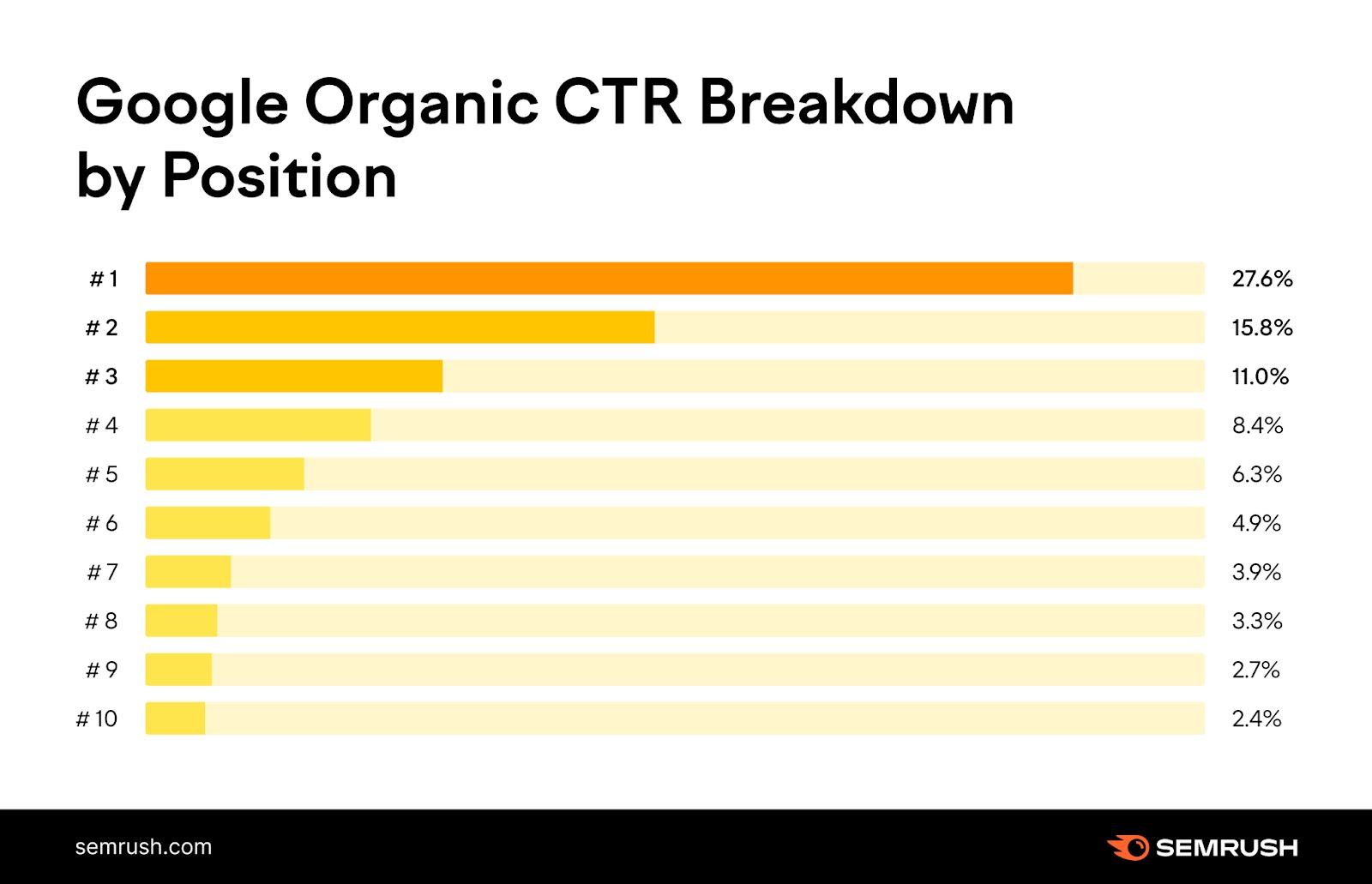
When a person searches on Google, Google’s search algorithms comb through its indexed content to determine which pages are the most credible and relevant to that particular search. And those pages are the ones shown in the SERP.
With search engine positioning, the goal is to get your content to the top of that list by boosting factors like:
- Content quality: How well your content offers value and relevance for the topic
- Relevant backlinks: The quantity and quality of links from other relevant websites that point to your site
- Mobile-friendliness: How fast your page loads on cell phones and how easy it is navigate
- Page performance: How fast (or slow) your page loads and functions for users
Further reading: The Art of Content Optimization: The Complete Guide
Why Is Search Engine Positioning Important for Your Business?
Search engine positioning is an important SEO strategy because it helps people find your business when searching for terms and products relevant to your brand.
The higher your pages rank, the more visible your business becomes to potential customers. This increased visibility can drive more traffic and revenue.
By not devoting time to web search engine positioning, you may lose rankings (and business) to your competitors who are actively working to get their content in those high-visibility spots.
Besides ranking for standard organic results, search engine positioning can even help you score a featured snippet. This is an excerpt of text that appears at the top of the SERP.
For example, this is the featured snippet for the Google query “how to start a business”:
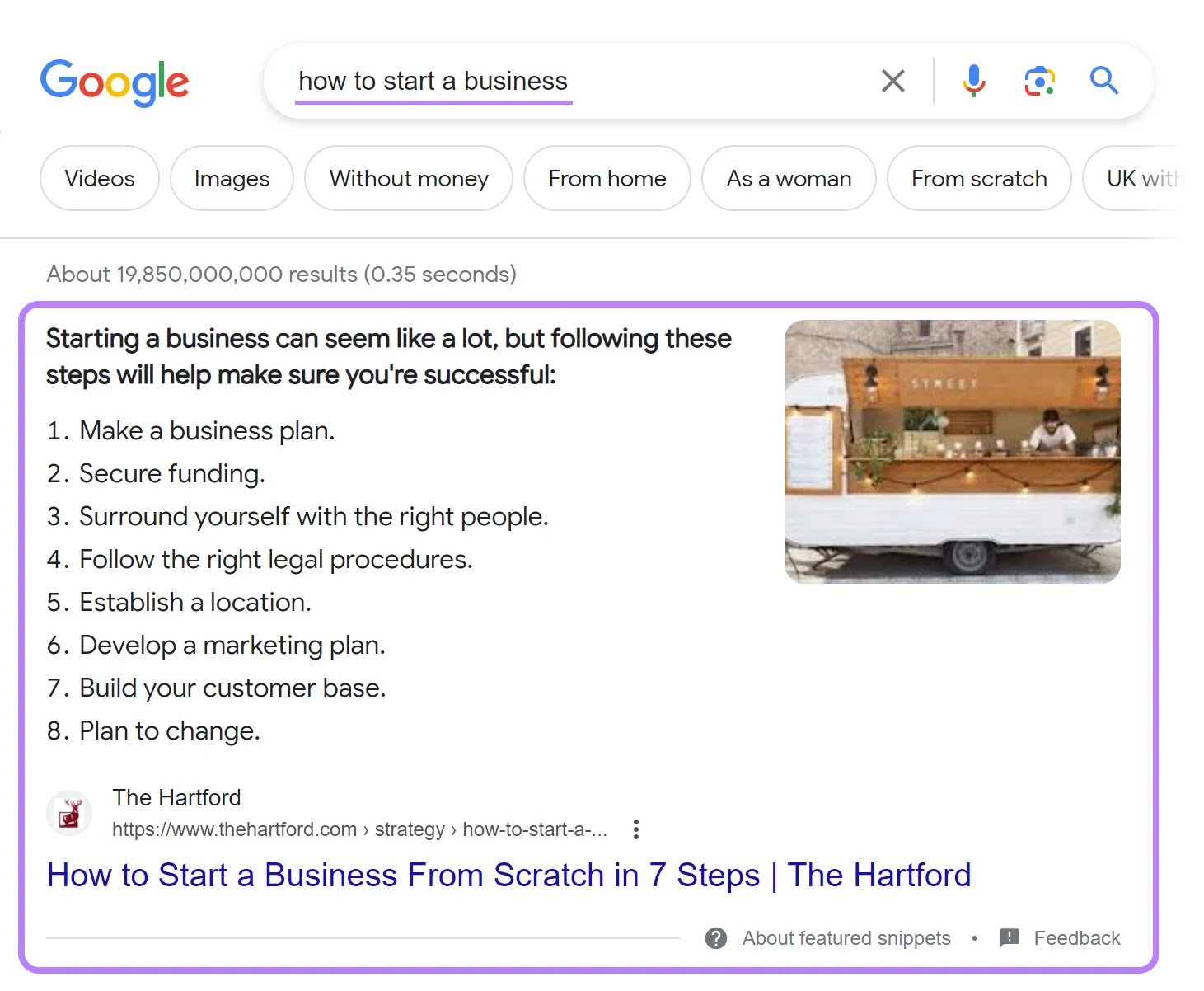
These snippets grab attention and position your brand as a trusted authority. Because featured snippets are the first thing a user sees in the SERP, they’re likely to click on them.
So, you want to try to rank for them over your competition.
Benefits of Search Engine Positioning
Strategic search engine positioning is key for building a successful online presence.
Here’s what it gives you:
1. Better Brand Visibility
Search engine positioning can help your web content appear higher in the SERPs by optimizing a specific page for a set of relevant keywords, improving content quality, and improving user experience (UX).
And as we mentioned before, higher positions in search results get more clicks.
2. More Organic Traffic
Higher rankings help drive more organic traffic to your webpages.
Search engine positioning is a cost-effective, sustainable way to bring potential customers to you. Unlike pay-per-click (PPC) models, the traffic from organic listings doesn’t cost you money (i.e., you’re not paying the search engine for listings).
Not every website visitor will buy something from you right away. But search engine positioning helps you meet different prospective customers where they’re at, getting content in front of them that reflects different search intents:
- Navigational: The searcher is looking for a specific page or site
- Informational: The searcher is looking for information on a topic
- Commercial: The searcher is researching products and services
- Transactional: The searcher is looking for specific products and services, and is ready to buy
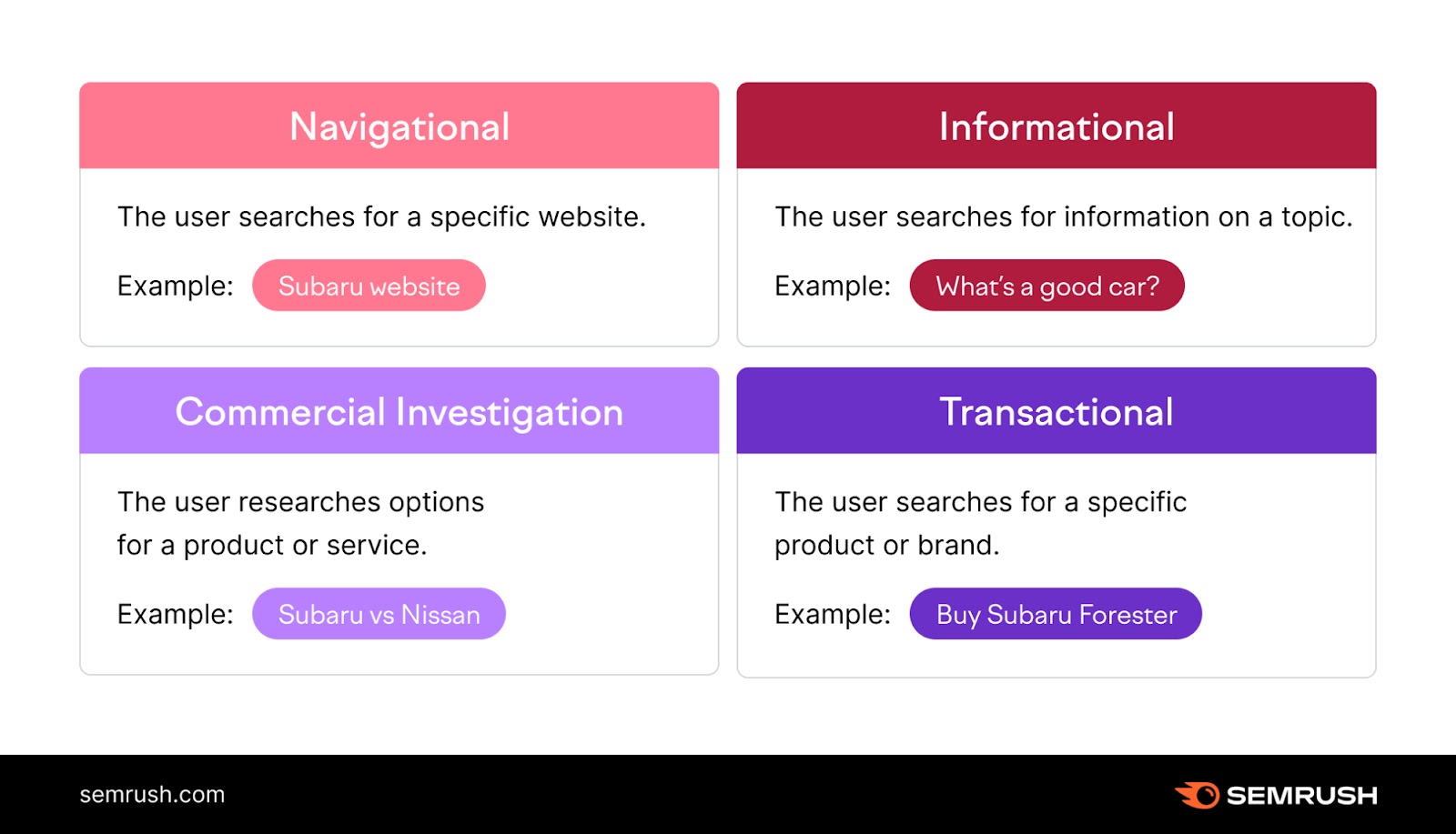
This helps establish an authentic connection and trust between users and your brand, helping to naturally shift them along in their customer journey.
3. A Competitive Advantage
No matter how niche your industry is, you’ll still compete with similar brands for the attention of the same target audience. But only one website can land the top spot for a keyword.
Devoting time and resources to search engine positioning can give you the edge over competitors who aren’t giving it as much attention. When your pages rank higher than your competitors’, traffic that might’ve gone to them is more likely to come your way.
For example, a dry ice business that delivers to a specific region might find the competition relatively low. To solidify its presence as the top area brand, it might optimize its service page with keyword-oriented details like:
- Service details
- Ordering process steps
- Pricing and payment information
- Quality assurance information
- Delivery logistics
- Safety information
- Customer testimonials
- Contact details
- Frequently asked questions
- Calls to action
Targeting relevant keywords while providing helpful information and value will help the dry ice business rank higher than competitors whose services pages have thin content.
As another example, pretend you’re an online reseller of Nike “Panda Dunks,” one of the most popular sneakers in the world. Here, the search landscape is incredibly competitive.
For your Panda Dunks collection page, you’ll need it to shine in ways the competition doesn’t. Maybe they don’t include testimonials or frequently asked questions, and their page speed lags.
So, you’d concentrate on optimizing your page to cover these aspects in an effort to move ahead of those competitors.
Further Reading: What Is a Competitive Analysis & How to Do It (With Template)
4. Greater Brand Recognition
Creating content that demonstrates Experience, Expertise, Authoritativeness, and Trustworthiness (E-E-A-T) helps maintain your credibility in the eyes of Google’s Quality Raters as well as users. This, in turn, can indirectly boost your rankings.
And consistently retaining those top positions helps you strengthen your reputation. Seeing your brand name pop up first in relevant searches tells searchers that your brand is trustworthy. Which can have a positive impact when it comes time to buy.
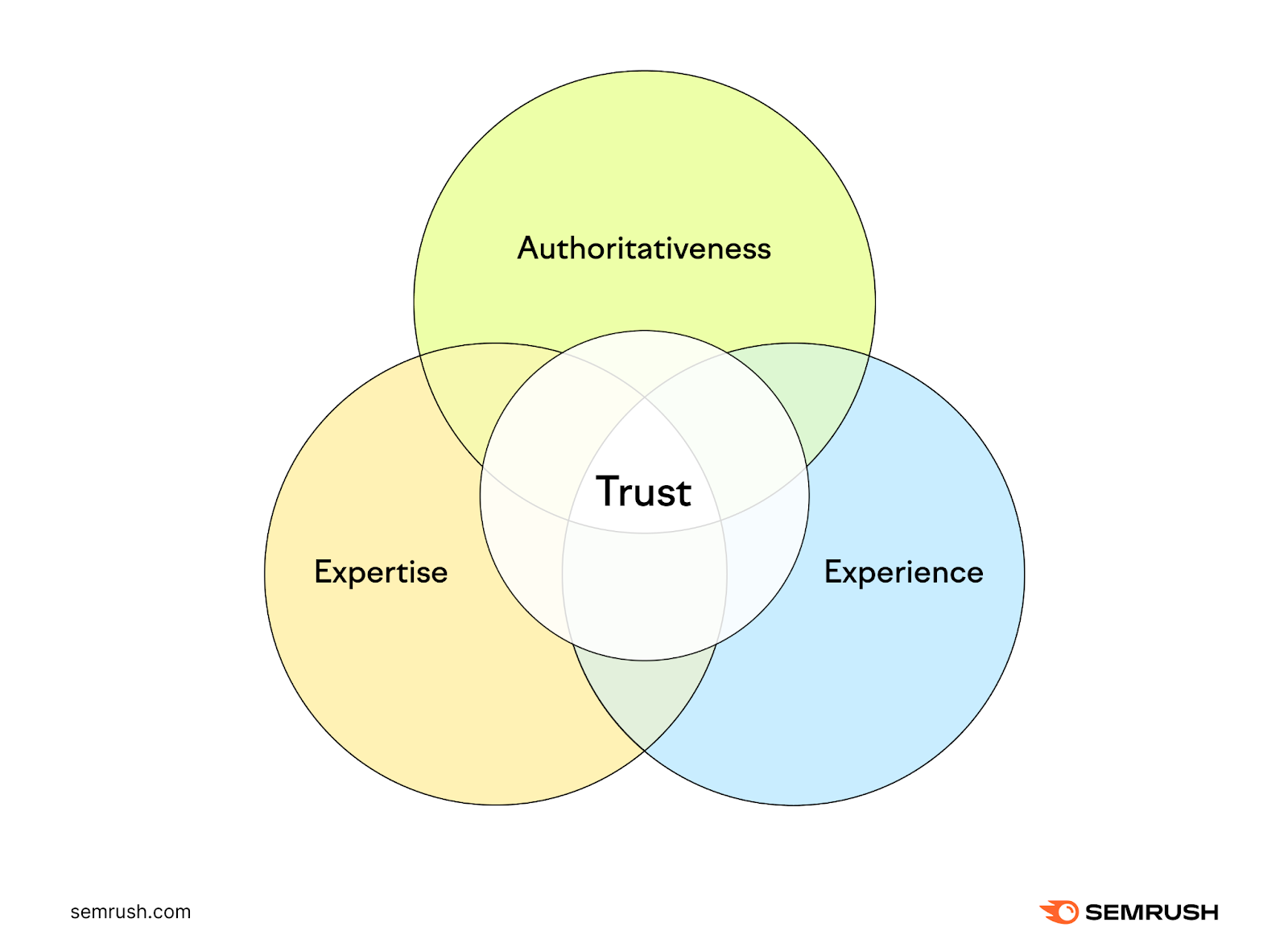
Search Engine Positioning vs. SEO: Understanding the Differences
While search engine positioning and SEO are related concepts, they’re not the same thing.
Main Focus
SEO is a comprehensive strategy for improving search visibility and performance for your entire website. It tackles a bunch of different areas, like:
- Keyword research
- Content creation
- Site architecture
- User experience
- Page speed
- Conversion rate optimization
Say you’re an athleisure retailer. Your SEO would likely involve developing a variety of content—like different landing pages, user testimonials, and informative blog posts on fashion and sport trends—to attract a wider audience and establish your site as a go-to resource for athleisure.
On the other hand, search engine positioningis a branch of SEO that zeroes in on specific pages, aiming to boost their visibility in search results.
Using the same example, search engine positioning means you would focus on a collection or product page you want to improve rankings for, such as workout shorts. By tailoring that page with workout shorts-related keywords, relevant information, internal links to related pages, and improving page performance, you’re trying to get that page to rank highly for the specific target terms.
Timeline
SEO is a long-term strategy designed to improve your website's overall quality, relevance, and rankings. Even Google says SEO can take four months to a year to see results.
But with search engine positioning, it is possible to see position results for your website pages within a few days based on Google indexing—though it could be a month or longer.
However, this doesn't necessarily mean that your pages will rank well immediately. But any effect from changes made to your page can be seen within days.
You can possibly expedite this process by prompting Google to index or reindex your page immediately after making changes in Google Search Console.
To request Google to re-index your page after you’ve optimized it, enter your page URL in the search bar at the top of Search Console.
Hit the “Enter” key on your keyboard, and the tool will show you the indexing status.
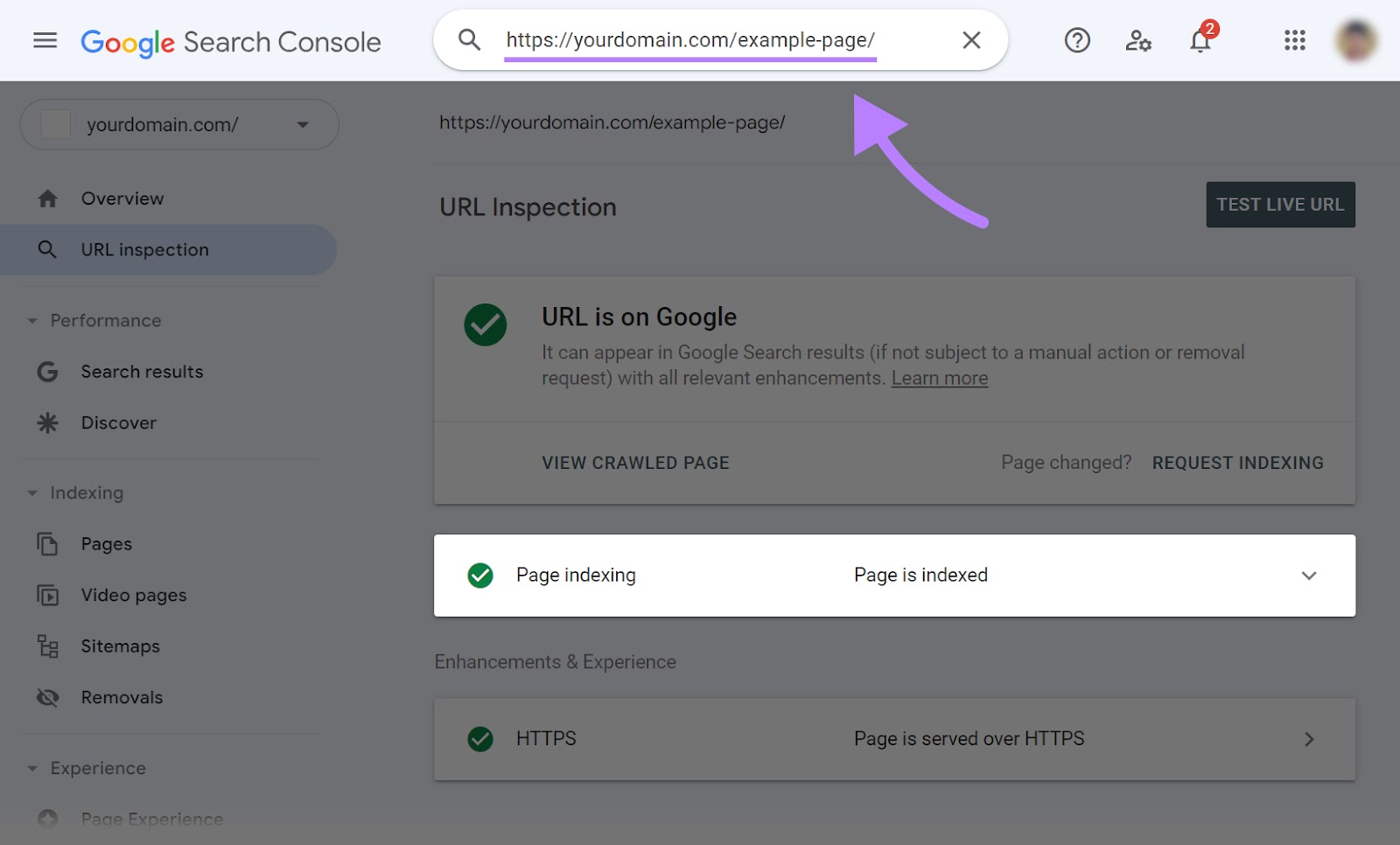
Even if the page is already indexed, you can click “Request Indexing” to inform Google that your page has changed and needs to be crawled again.

Further reading: How to Get Your Website Indexed by Google
Best Practices for Search Engine Positioning Improvement
Ready to become a search engine positioning into action?
Here are several best practices to optimize your pages to improve their position on search engines. While these tactics are meant to improve specific page rankings, remember that some may overlap with your overarching SEO strategies.
Create High-Quality, Targeted Content
The content of your page—whether it’s a landing page, blog post, or something else—should be relevant to the topic it covers, offering real value that speaks directly to your target audience.
If it’s not relevant or doesn’t meet search intent, Google probably won’t show it on the SERP.
Semrush’s Topic Research tool is a great starting point to help you come up with search-friendly content ideas that resonate with your readers.
Enter a topic and click the “Get content ideas” button.
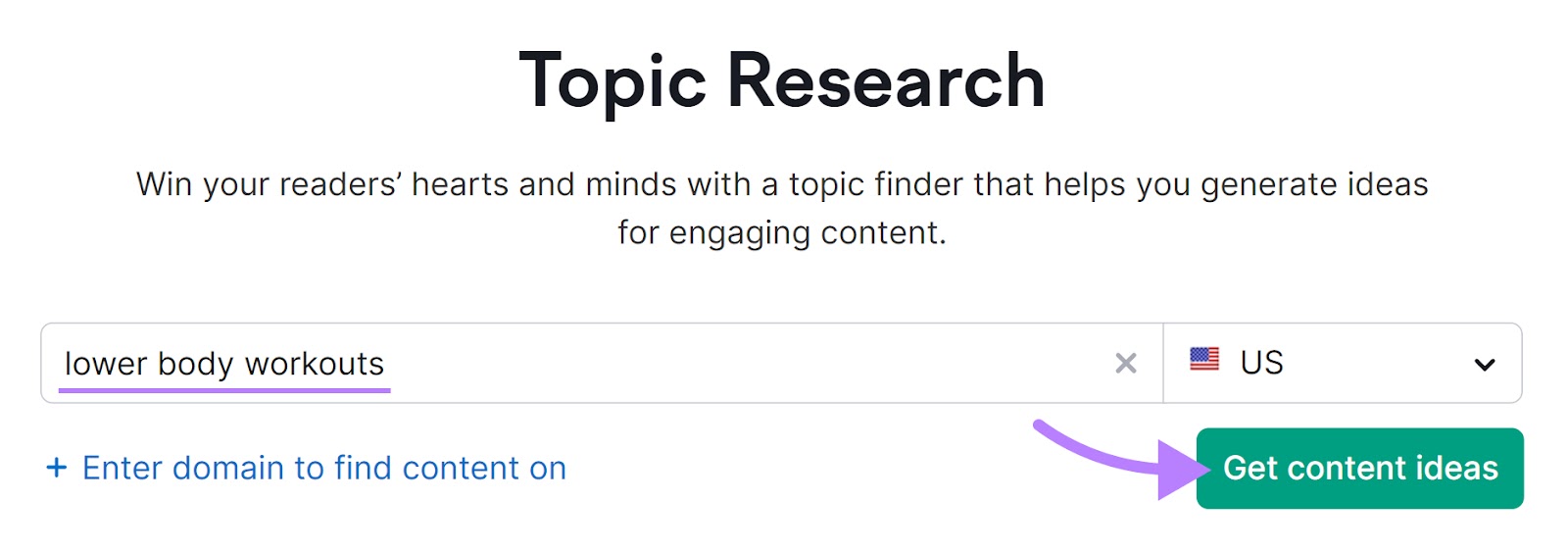
You’ll then see a dashboard of related content ideas:
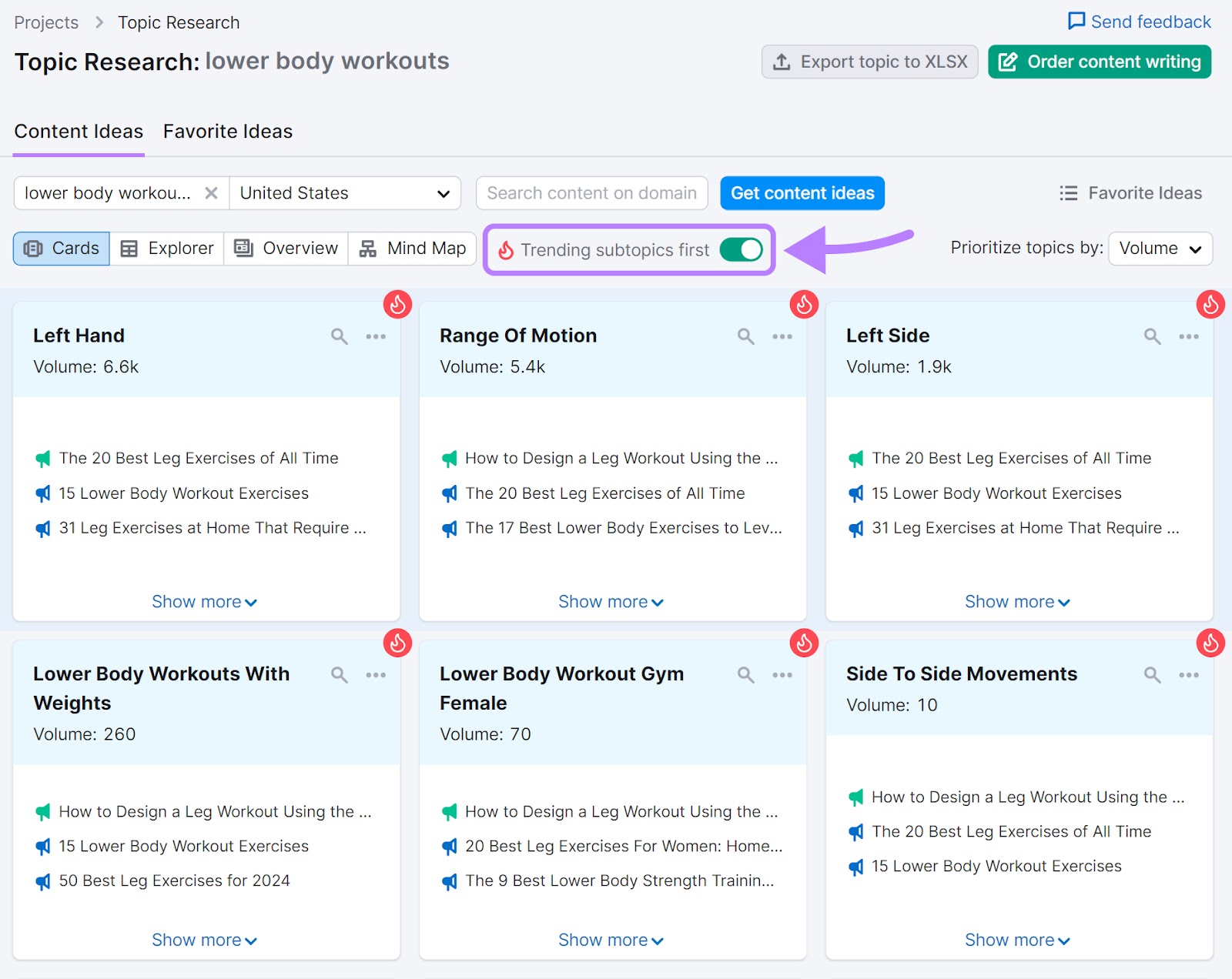
Click the “Trending subtopics first” slider to organize the results by volume.
Besides monthly search volume, each card shows you the topic difficulty and efficiency. And headlines of related articles and questions.
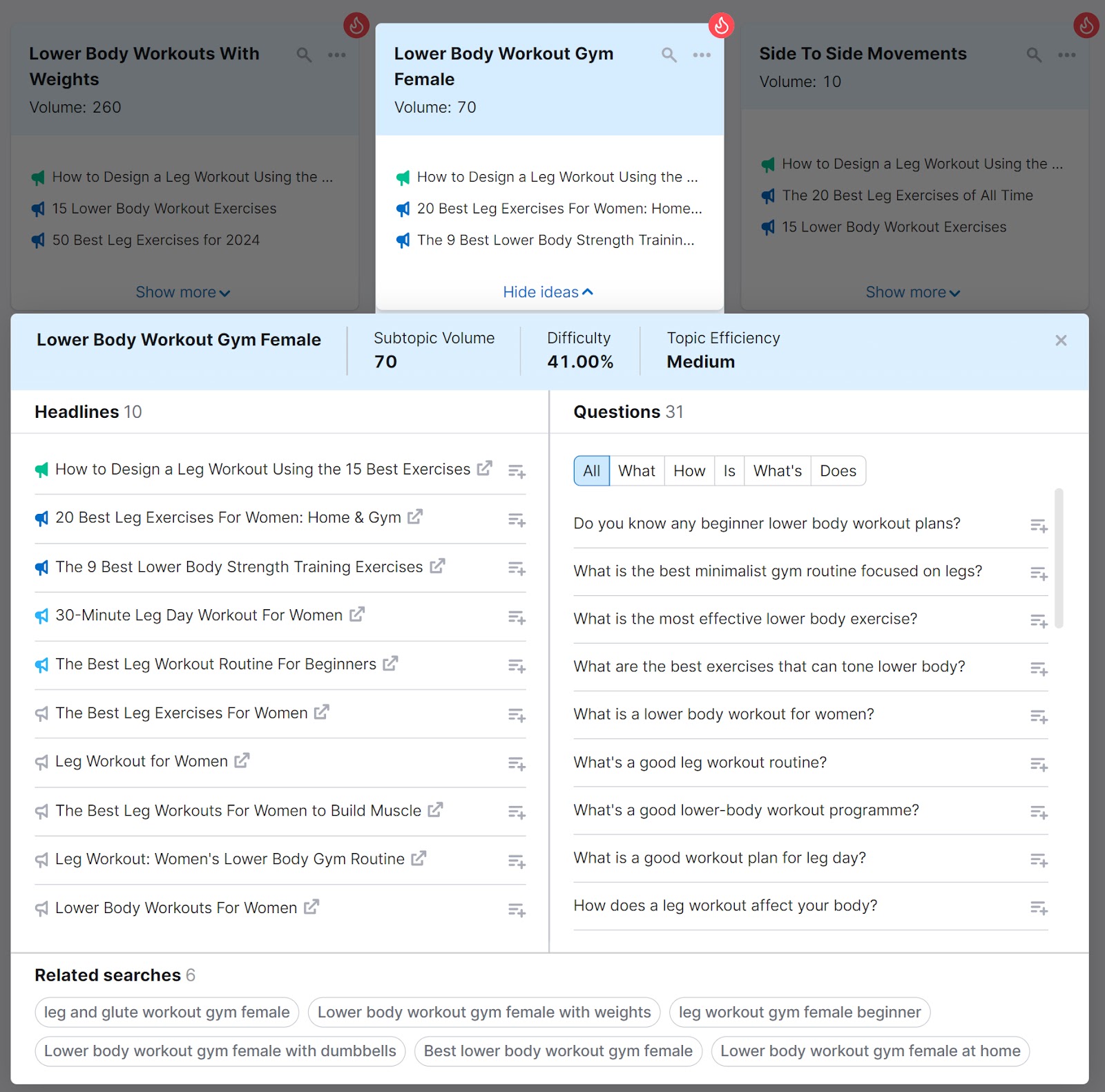
Once you have your ideas nailed down, head over to our content creation guide for tips on creating top-notch resources for users.
Refresh Existing Content
Traffic to your content can drop when:
- Competitors boost their own search engine positioning efforts and outrank you
- Google updates its search engine algorithms
- Your information is dated or no longer accurate
Revisit and update your content that drops in rankings to ensure it’s still relevant, offers helpful information, and meets searcher expectations.
The SEO Writing Assistant makes it easy to refresh content.
Log into your Semrush account. Then, navigate to “SEO Writing Assistant” in the left-hand column. Click the “Analyze my text” button.
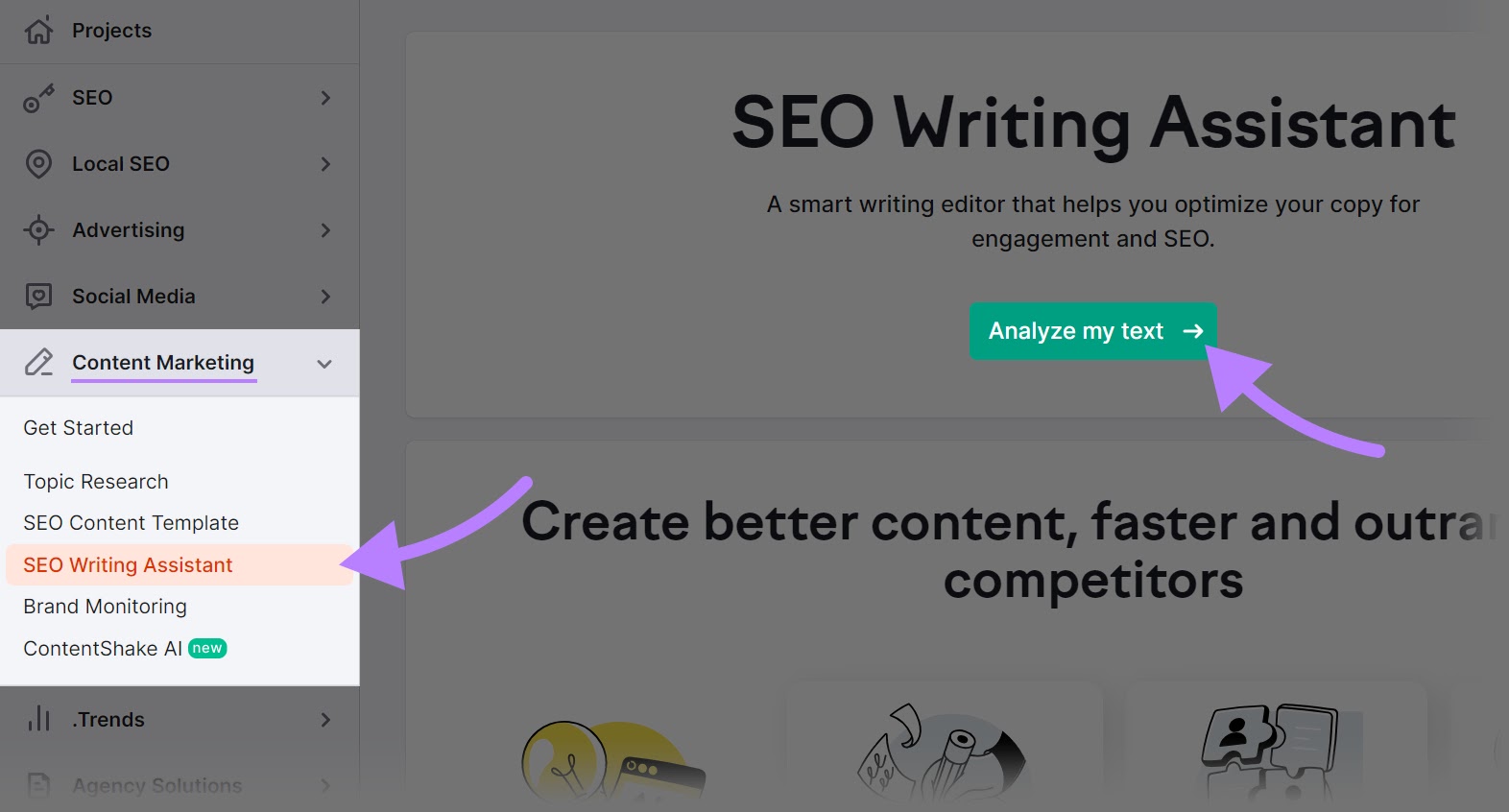
Then, you'll see scores on your:
- Readability
- SEO
- Originality
- Tone of Voice
Along with recommendations on how to improve each category.
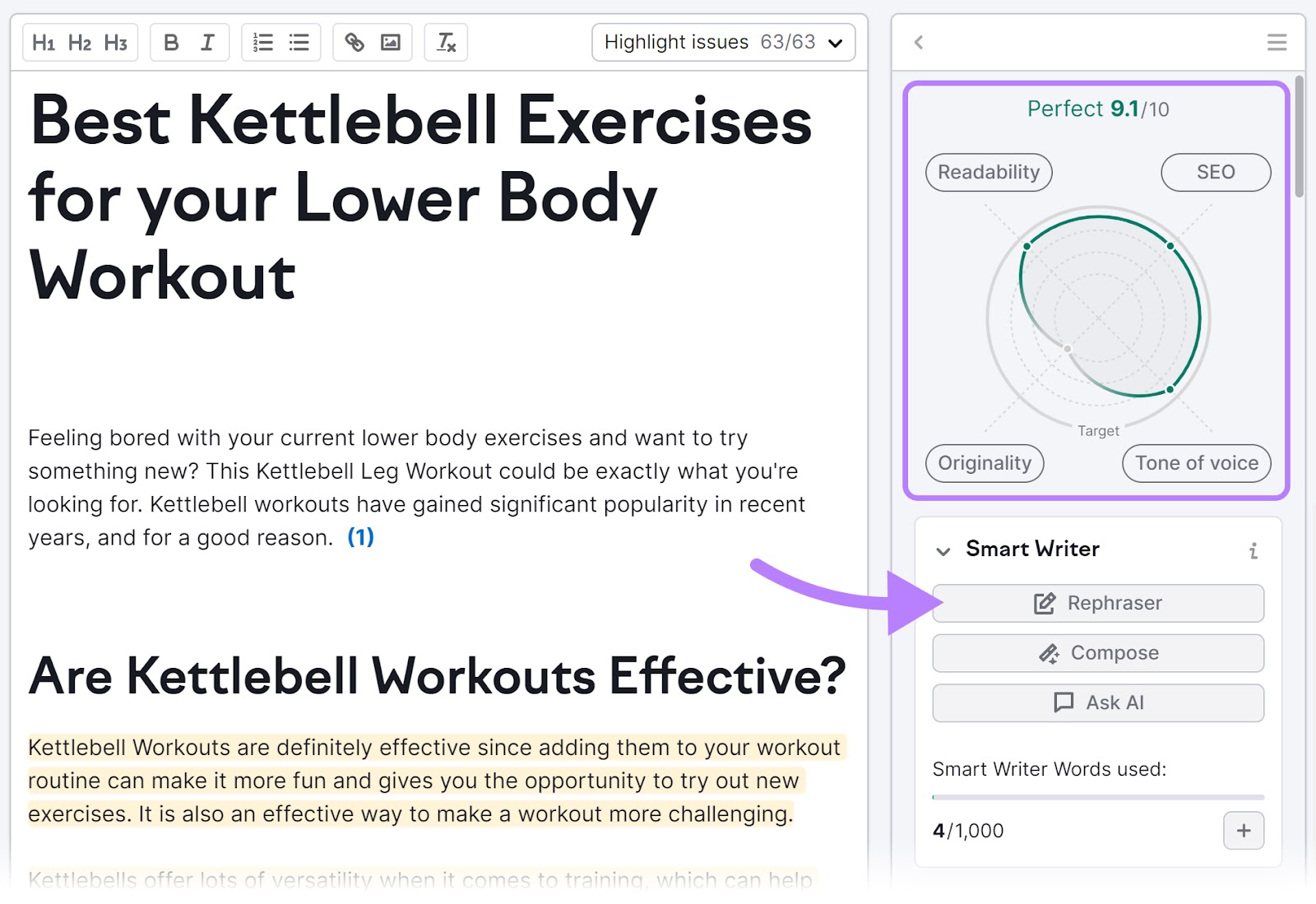
If you want to revamp specific sections, click “Rephraser” under “Smart Writer” on the right side.
You’ll then see different buttons that tell the AI to:
- Rephrase: Change the wording of your text
- Simplify: Make your text easier to read
- Expand: Add more text
- Summarize: Condense your text to highlight its key points
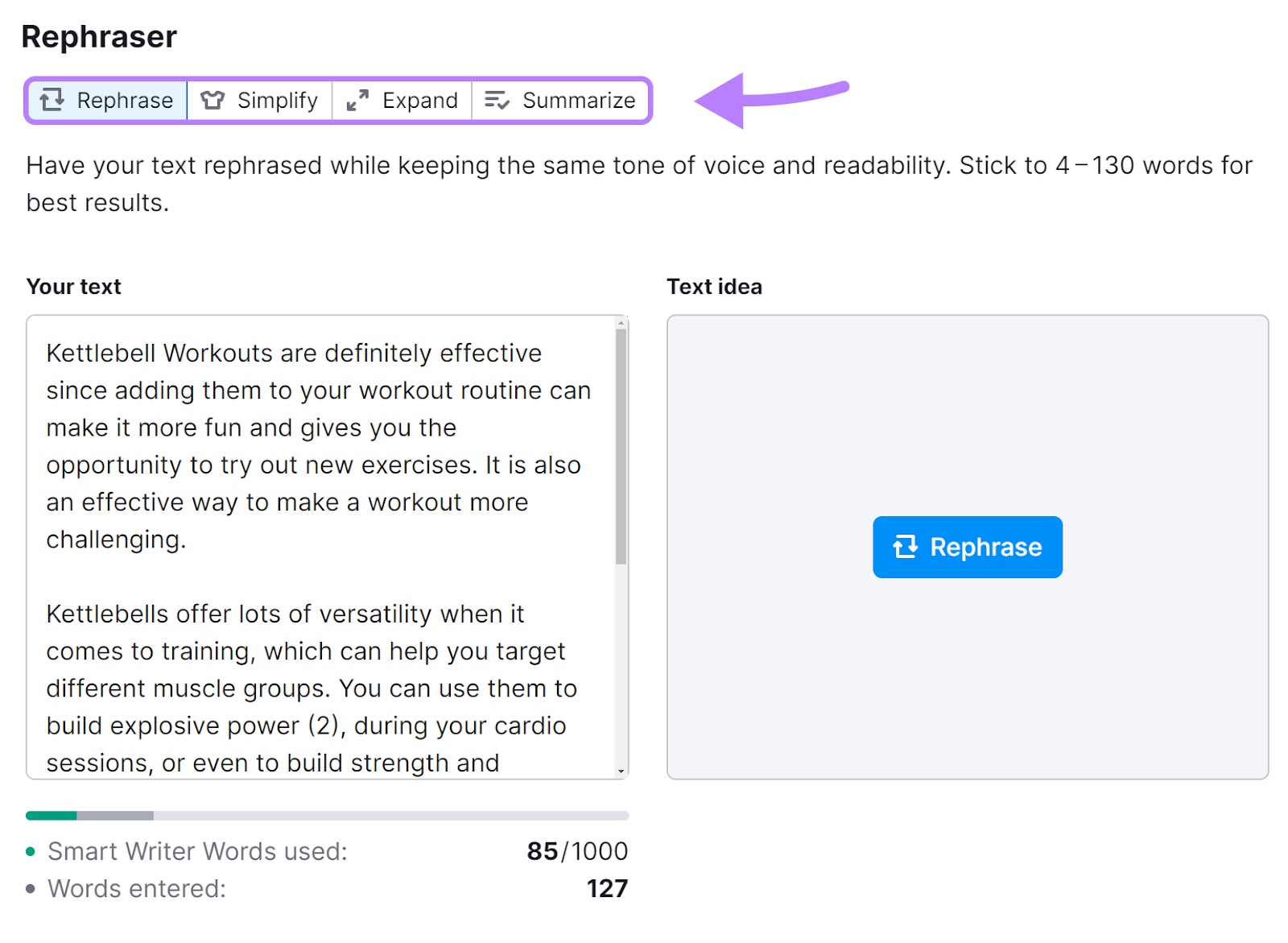
Focus on On-Page SEO
As we previously mentioned, SEO is the umbrella strategy that includes search engine positioning. And improving your on-page SEO makes it easier to rank higher.
We’re only giving two simple, beginner-friendly examples of on-page SEO in this section. But you can dive deeper into other techniques in our on-page SEO guide.
Use Strategic Internal Links
Internal links are hyperlinks on a website that point to other pages within the same site.
For example, the “internal links” link in the previous sentence is, in fact, an internal link.
You use internal links to show Google how your content is related. And help it find new pages to index.
Additionally, internal linking helps you pass on link equity, or ranking power, from high-performing pages to ones with fewer clicks. This helps get more of your content seen as authoritative and relevant, which helps boost their rankings.
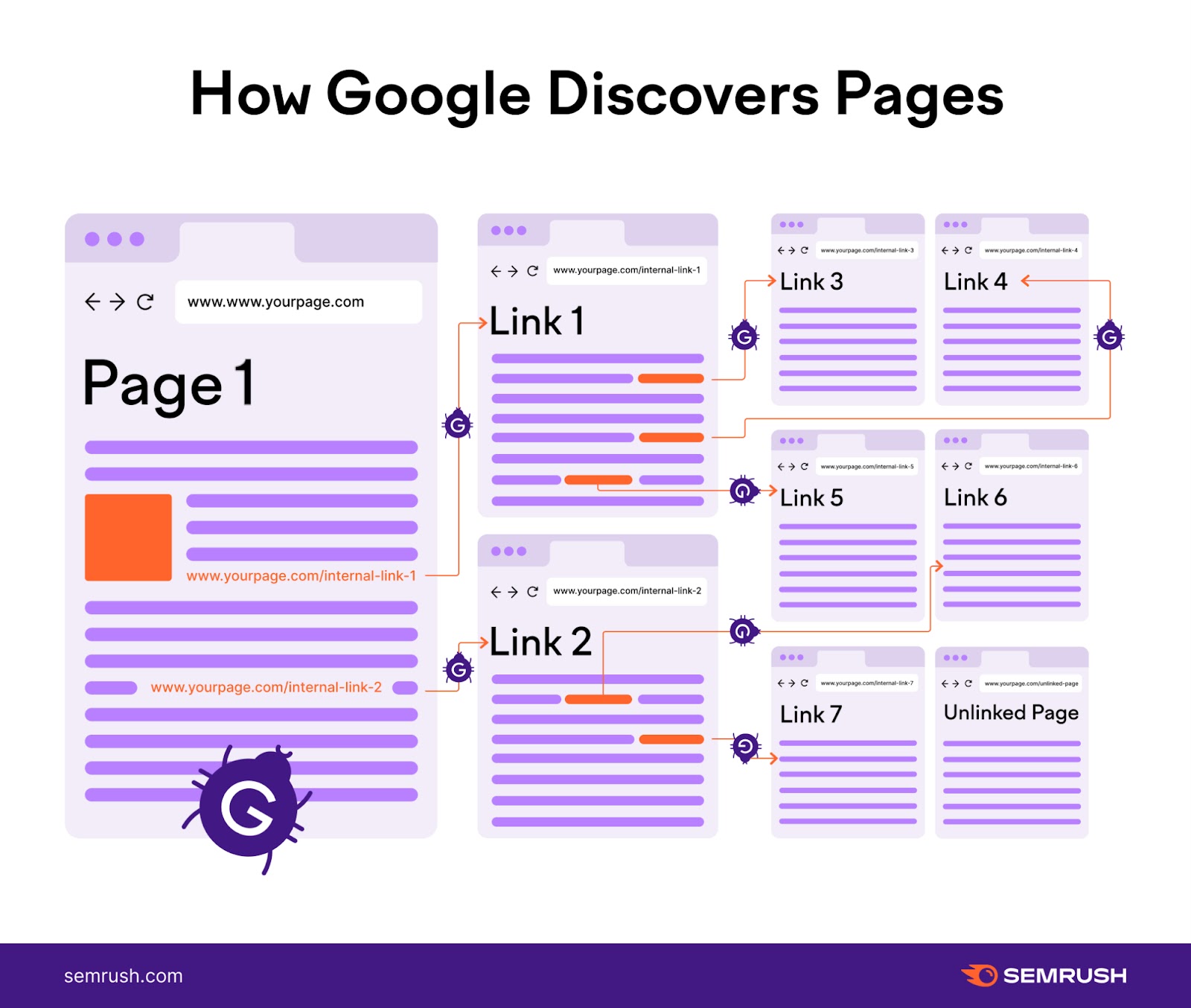
Internal links also make it easier for website visitors to find additional relevant content. Which boosts traffic and helps them see your brand as an expert.
Here are some tips for using internal links to keep visitors engaged on your site:
- Use specific anchor text: Use descriptive anchor text instead of text like “click here” so readers know what the content will be about. As an example, this bullet has a link that reads “anchor text,” clearly reflecting the topic of the linked page to readers.
- Be brief with anchor text: Limit to around five words, so it’s clear what the topic of the linked page is about
- Focus on quality over quantity: Links should always be relevant and helpful to readers—too many links on a page can look spammy or confusing.
- Fix broken links: No links should lead to a 404 error (page not found). Fix broken links by changing the destination URL or redirecting it to a live page with a 200 status. Or delete the link.
Further reading: Internal Links: Ultimate Guide + Strategies
Optimize Your Title Tags and Meta Descriptions
Make sure your title tags and meta descriptions speak to your audience while remaining keyword oriented. This can help boost your organic click-through rate.
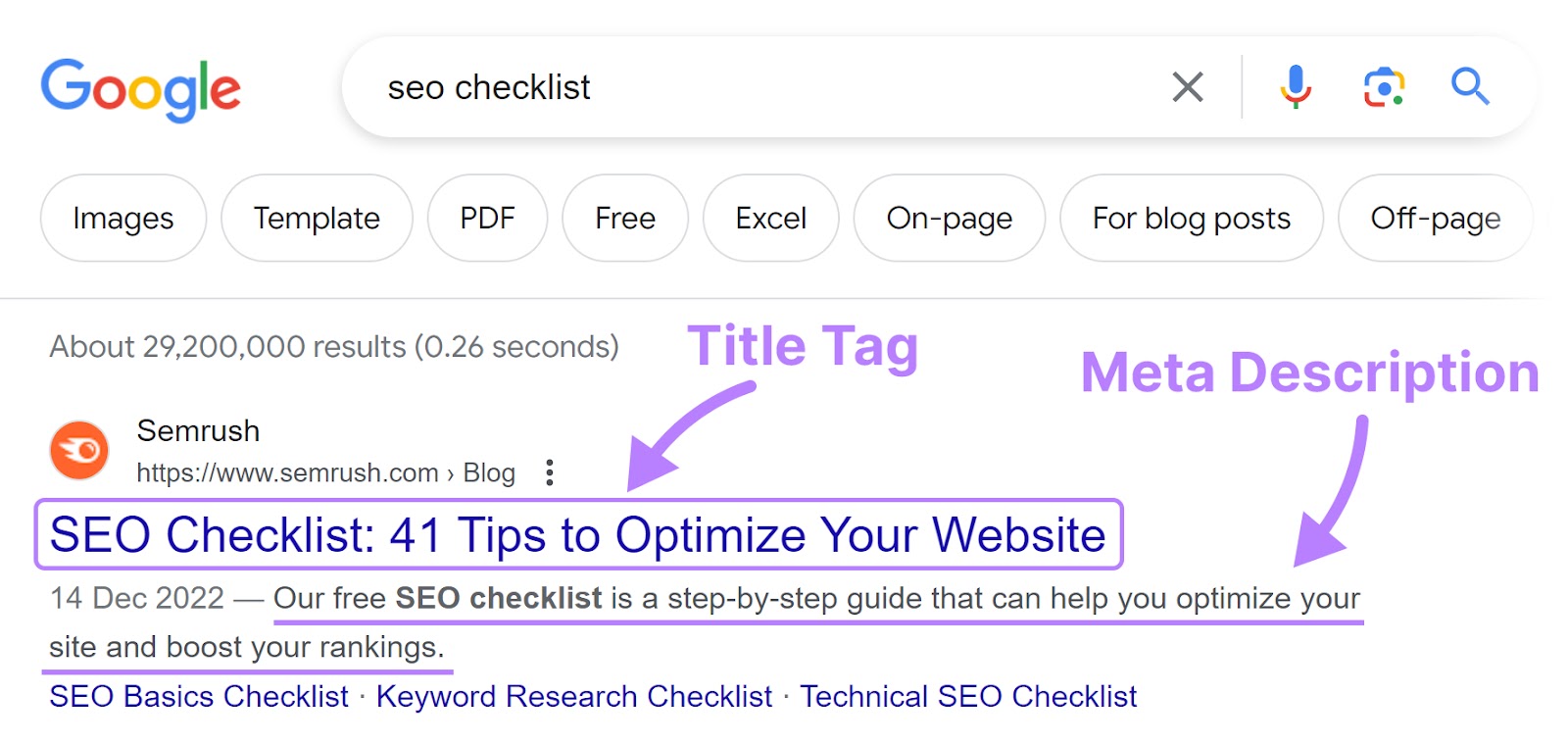
To avoid getting text cut off in search results, keep your title tag under 60 characters. And keep your meta description around 105 characters.
How to Measure Search Engine Positioning
Here are two search engine positioning tools to help you keep track of your page rankings:
1. Use Semrush’s Position Tracking
Position Tracking is a keyword tracking tool that allows you to compare your Google rankings in the first 100 spots with your competitors.
To start, enter your domain and click “Set up tracking.”

Select the search engine and device you want Semrush to use for tracking. We recommend starting with “Google” and “Desktop.”
You also must enter a “Location” before you can continue.
Click “Continue To Keywords.”
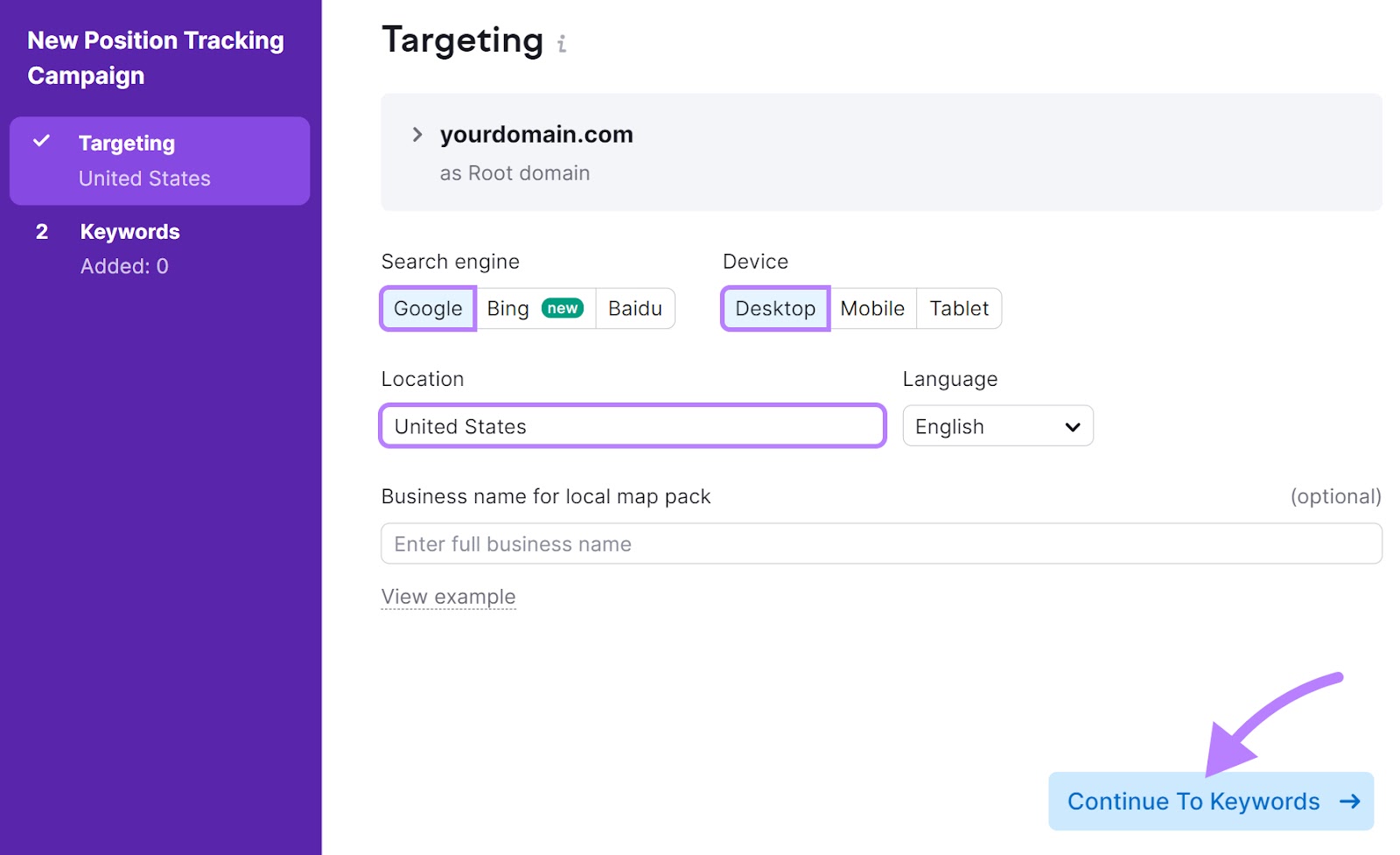
Manually enter or import your target keywords and click “Add keywords to campaign. > “Start Tracking.”
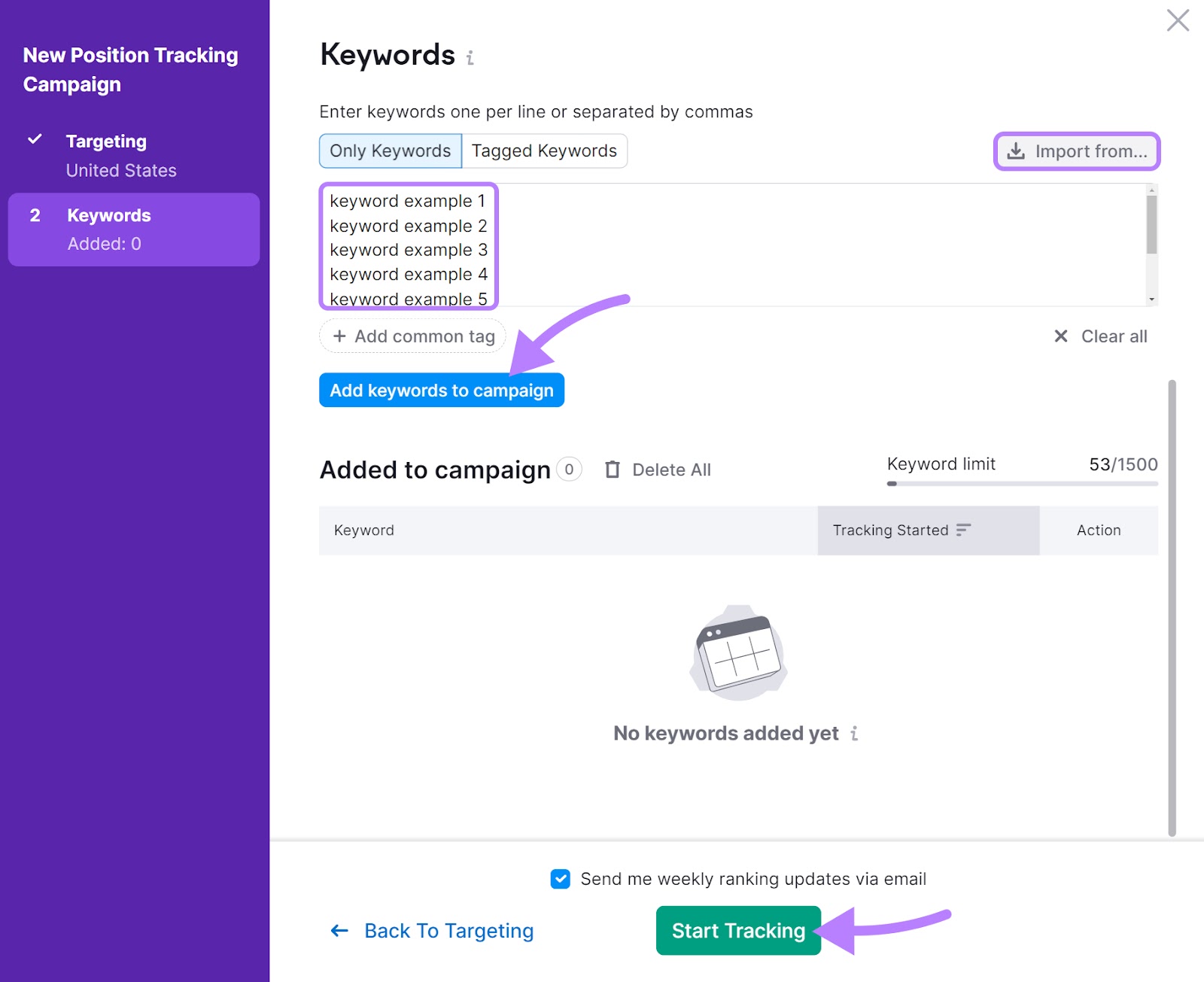
The tool will then generate a summary with your domain’s visibility, estimated traffic, and average position for your tracked keywords in the “Landscape” report.
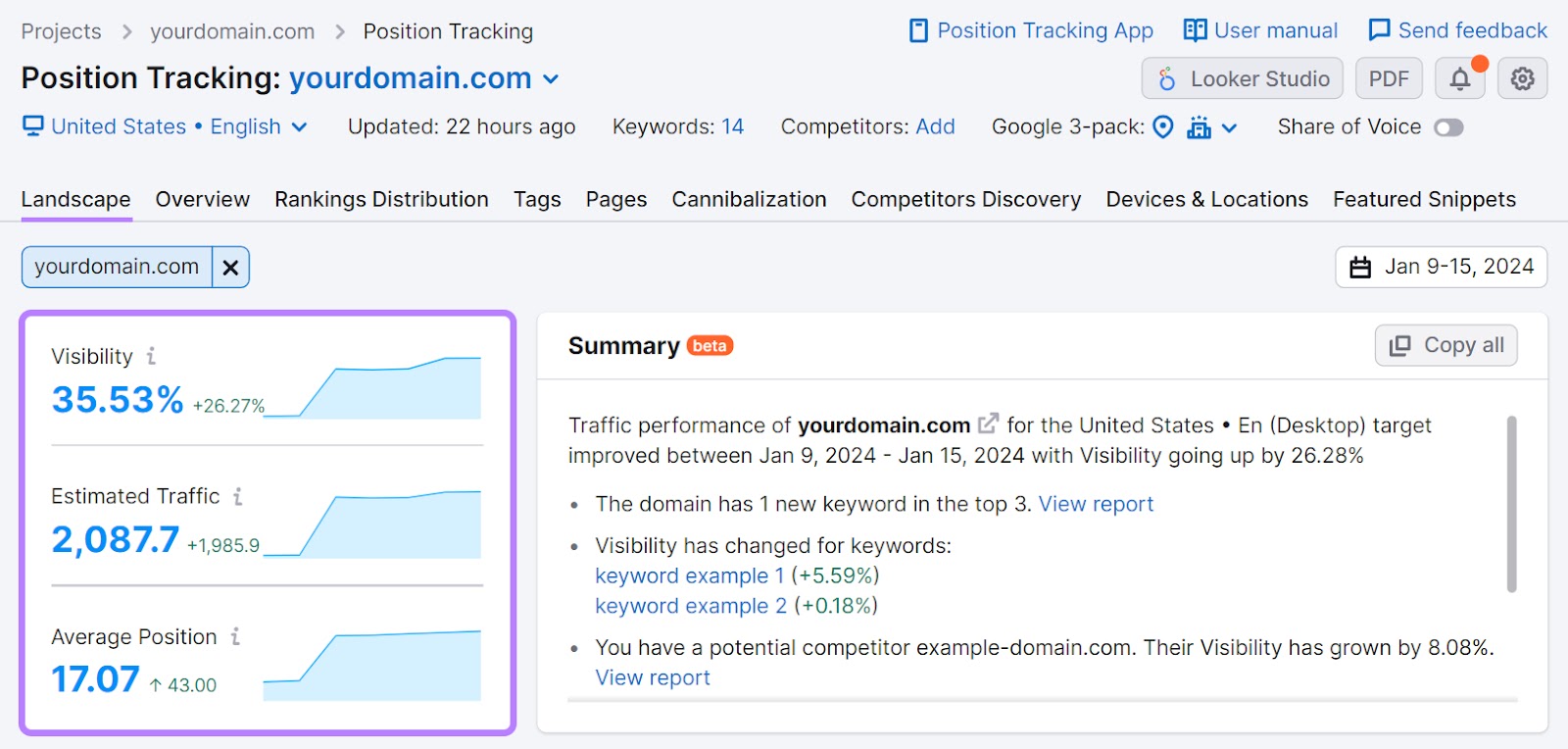
The “Overview” tab shows how your rankings and visibility have changed over time.
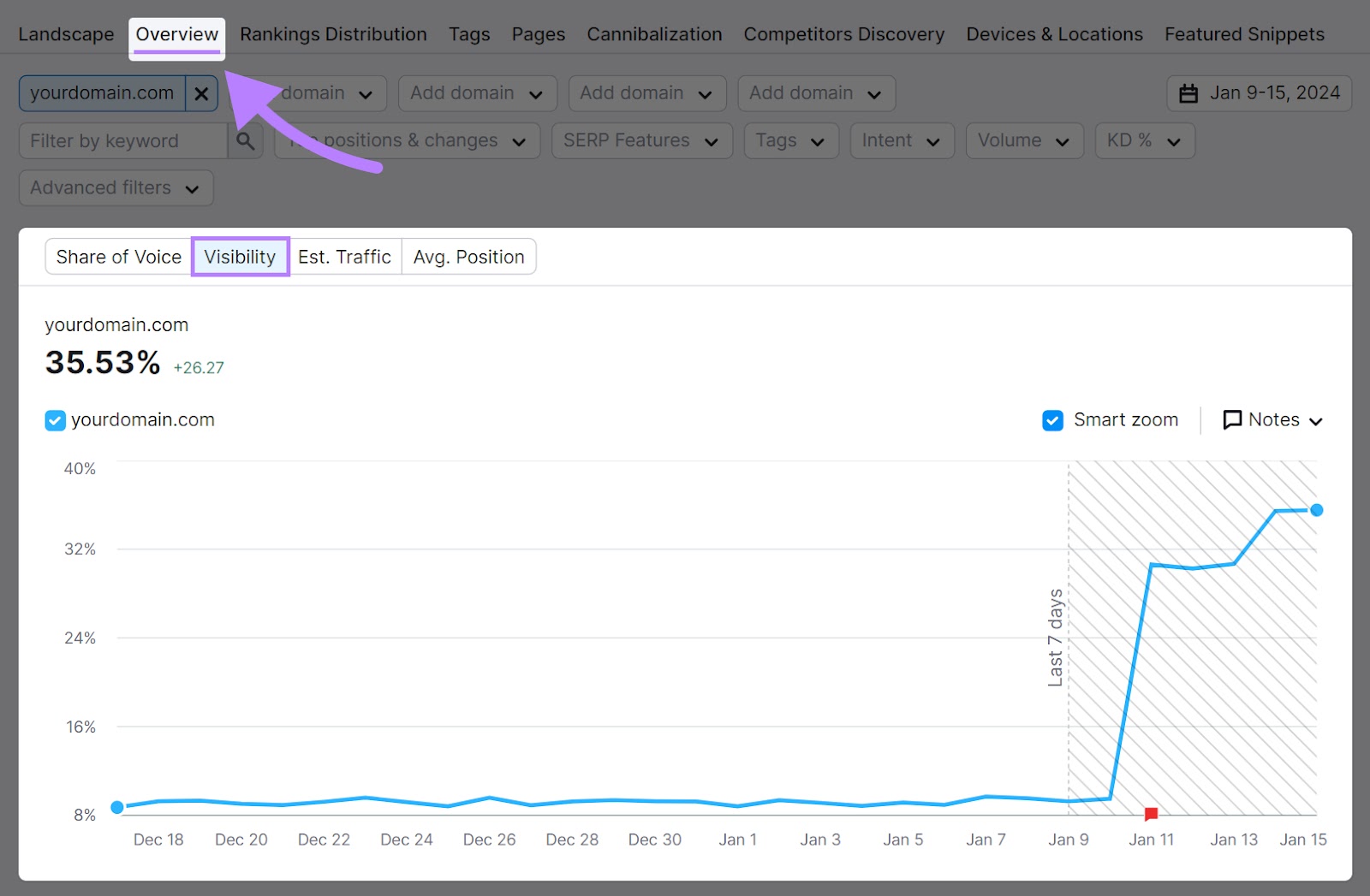
2. Use Google Search Console
You can also measure the impact of your search engine positioning efforts in Google Search Console.
Log in to Search Console and select your website in the property dropdown.
On the overview page, you’ll see the “Performance” chart that shows your website clicks. This is a quick way to see trends in your organic traffic.
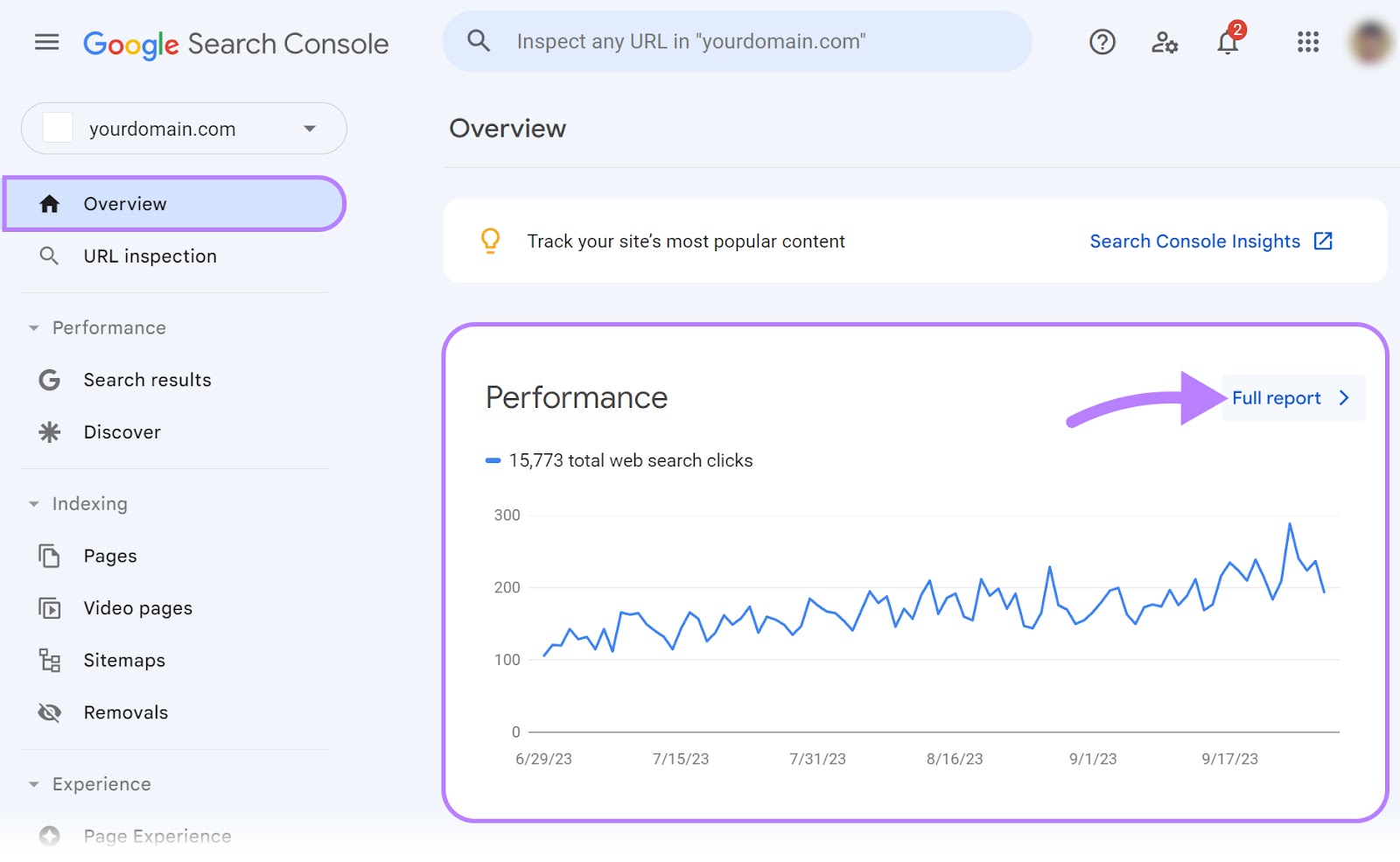
Clicking “Search Results” under the left-hand “Performance” category will take you to a more detailed chart showing:
- Total clicks
- Total impressions
- Average CTR
- Average position
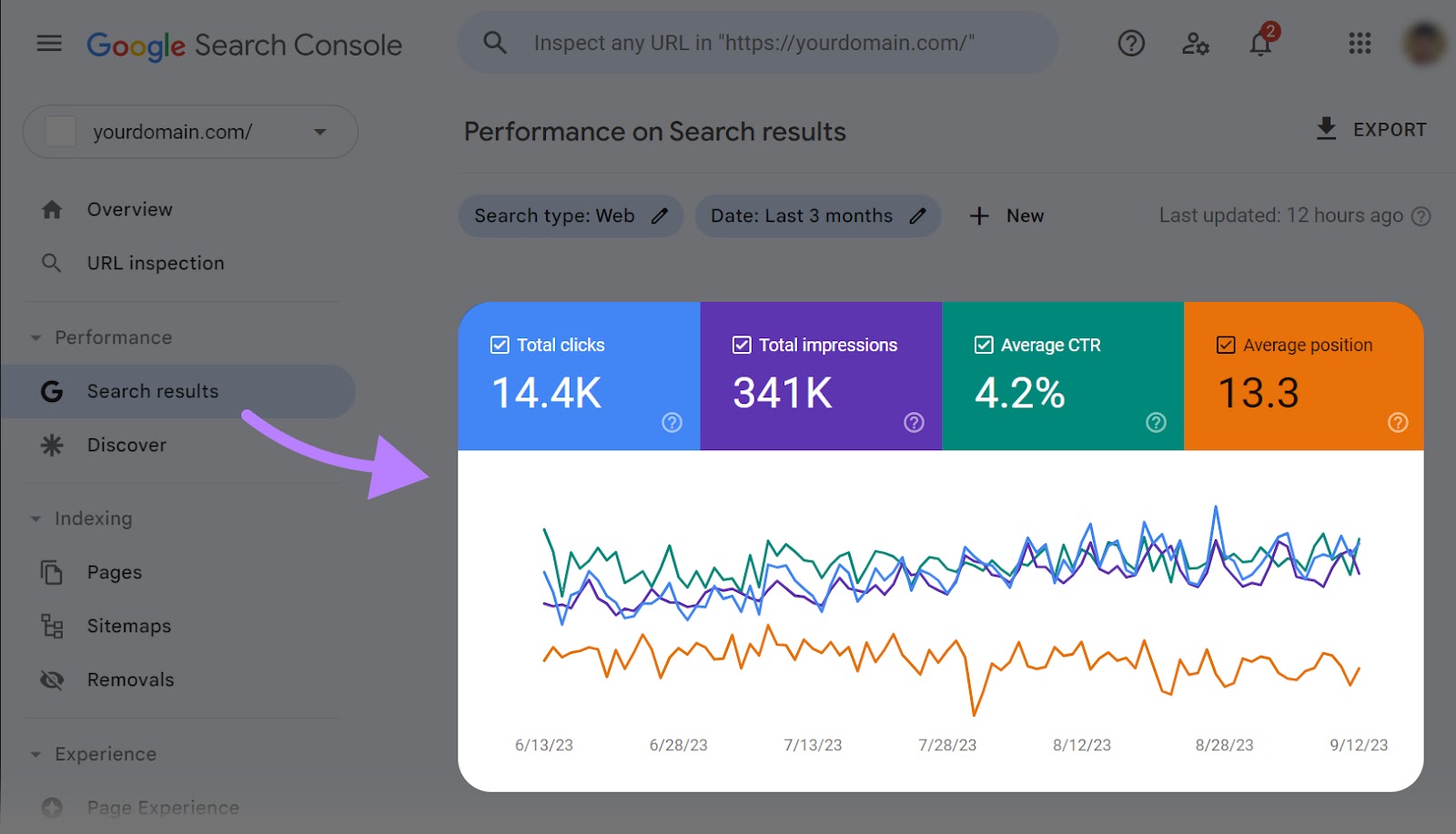
You can filter by specific dates or pages. And use the average position metric as your benchmark for measuring your search engine positioning over time.
Search Engine Positioning is Foundational to SEO
Whether you’re a search engine positioning expert or just starting out, remember: this is an ever-changing process.
So, it’s important to stay on top of your rankings with search engine positioning software. This way, you can identify what’s working. Or know when you need to give certain pages more TLC.
Use Semrush’s Position Tracking tool to track keywords and measure the effectiveness of your search engine positioning efforts. Easily stay on top of changes with automatic notifications that tell you when your pages go up or down on the SERPs.
